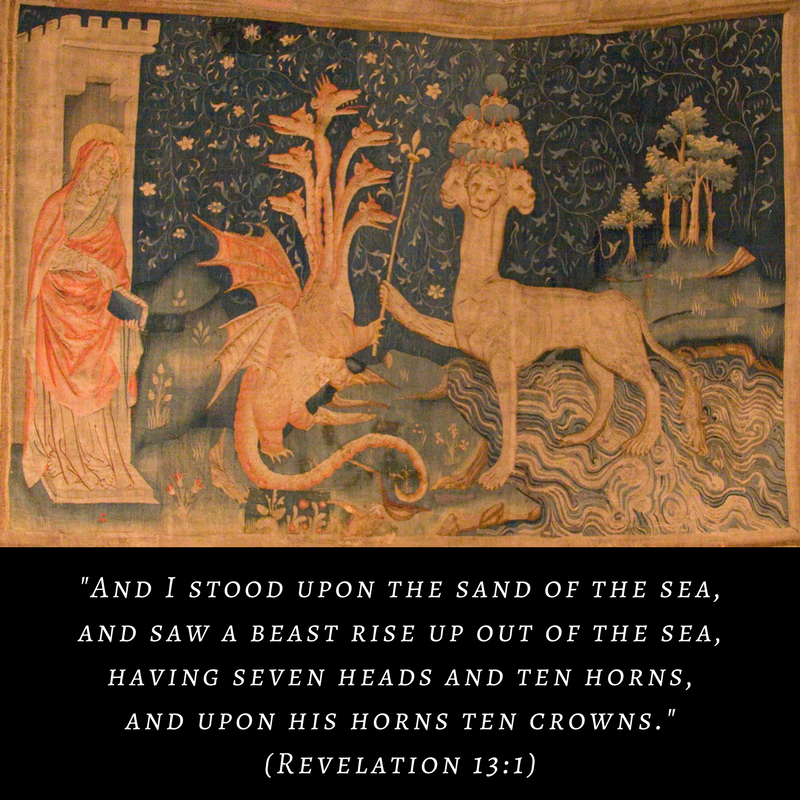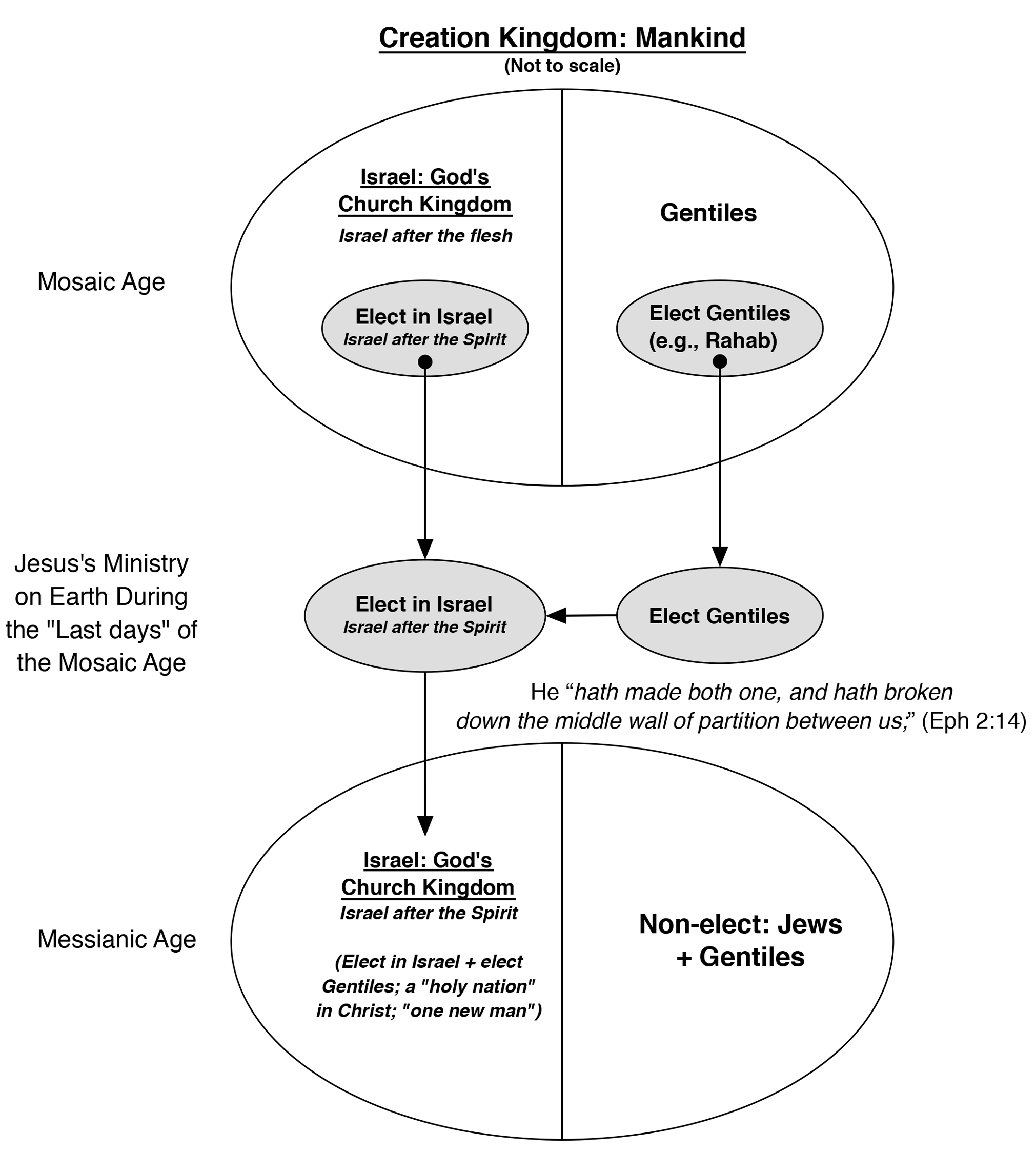
666 conjures up mystical images of evil. That fact that 666 is the sum of the numbers on a roulette wheel, or that the Aryan Brotherhood uses it in tattoos, or that Apple, Inc. used it as the name of a wicked computer virus does not surprise us.1 Many Christians believe this will be the number of a supremely evil person (or supercomputer) at the end of time.
The most famous reference to this number is in the fourth vision of Revelation (Rev. 12:1–14:20). We will refer to this as The Seven Mystic2 Figures vision because of the seven “persons” who advance the plot.3 (By “mystic” we mean “symbolic,” not “occult.”)
The seven figures are, in order of their appearance: 1.) a sun-clad woman4; 2.) a great red dragon5; 3.) a man-child6; 4.) a beast from the sea—whose number is 6667; 5.) a beast from the land8; 6.) a Lamb on mount Sion9; and 7.) the Son of Man upon a cloud.10
Our application of inmillennialism to Revelation suggests we can find a natural and relevant identity for these seven figures. This prophetic framework teaches that Revelation’s five central visions11 are repetitive. Each describes God judging Israel in the first century.12 So, these seven figures must be present during this time. They must also take part in the climactic display of God’s wrath against Israel.
This central vision in Revelation plays a significant role in the entire book. Identifying its symbolic figures is necessary to understand the vision itself. This will, in retrospect, add clarity to the first two judgment visions. And, it will give the cast of characters for the remaining visions. As we will see, showing the ultimate outcome of these seven figures is the special task of the sixth and seventh visions.
This post suggests an identity for these seven characters. Inmillennialism teaches that they act in John’s near future13 and in the land of Israel.14 These are Israel’s “last days” (Heb. 1:2) and they culminate in the “great tribulation” (Rev. 7:14; cp. Matt. 24:21). During this time, the Temple falls, just as Jesus predicted (Rev. 11:1–2; cp. Matt. 24:1–3). This happened in AD 70.
The Sun-Clad Woman
The “woman clothed with the sun, and the moon under her feet, and upon her head a crown of twelve stars” (Rev. 12:1) is Israel. This imagery is ancient. Joseph used it seventeen centuries earlier to explain his dream: “Behold, I have dreamed a dream more; and, behold, the sun and the moon and the eleven stars made obeisance to me” (Gen. 37:9). His family knew these symbols represented Jacob, Rachel, and their sons—the incipient nation of Israel. It was also contemporary. Earlier in John’s generation, Jesus used it to represent Israel during the “great tribulation” of his generation (Matt. 24:1–3, 21, 29–30, 34).
We also know the Sun-Clad Woman is Israel because of God’s promise she would labor in childbirth and bring forth the Messiah (Rev. 12:2; cp. Isa. 9:6; 54:1; 66:7–8; Mic. 5:2; et al.). In John’s vision, the Woman gives birth to the One “who was to rule all nations”—the Lord Jesus Christ (Rev. 12:5). Israel gave birth to the Messiah in the “last days” (Heb. 1:2) of the Mosaic Age, during the reign of Augustus, the second Roman Caesar (Luke 2:1–7).
Tracing Israel through this vision is a complicated task. Mosaic-Age Israel, the nation as it existed under the old covenant,15 comprised two parts.16 The apostle Paul says one part had true faith in God; they were “born after the Spirit.”17 We will call this group Israel after the Spirit for convenience. The rest of Mosaic-Age Israel lacked faith and were part of the covenant nation only in external rites and ceremonies. These were “born after the flesh,” but not the Spirit. Paul refers to them as Israel after the flesh.18 To repeat, Mosaic-Age Israel comprised two groups: Israel after the flesh and Israel after the Spirit.
Furthermore, God was reconstituting Israel during the “last days” period covered by this vision. Under the old covenant, the law of Moses defined her existence: her membership, priesthood, ethics, etc. This changed under the new covenant. Now, God defines the “holy nation”19 as those in Christ. This transition was almost complete as John wrote.
Those Jews of John’s generation who believed in Christ—Israel after the Spirit—formed the nucleus of the new nation. To them, God added the elect Gentiles—those who believed in Christ—to form “one new man.”20 To use another figure, He grafted Gentile believers into Israel’s olive tree so they could partake of “the root and fatness of the olive tree.”21
During the Messianic Age, Israel comprises Jews and Gentiles who believe in Christ. There are no subdivisions in this Israel. We will refer to this “new man” as Israel after the Spirit or Messianic-Age Israel. Sometimes, the single name “Israel” will suffice.
The following diagram22 shows these relationships. It builds on two earlier posts23 and will aid our future analysis of the Sun-Clad Woman’s role in this vision.

As always, context determines which definition of Israel a writer intends. In most cases, John’s meaning in this vision is clear. As we have already seen, Mosaic-Age Israel gives birth to the Man Child destined to “rule all nations” (Rev. 12:1–5).
We will refer to this chart in future posts as we trace the Sun-Clad Woman through this vision.
The Great Red Dragon
John provides a clear identity for the “great red dragon.” He is “that old serpent, called the Devil, and Satan, which deceiveth the whole world” (Rev. 12:9). This evil being empowers the Sea and Land Beasts as they persecute the Woman and the Man Child.24 He enabled pagan empires in the past (Ezek. 29:1–3) and Israel’s prophets foretold God’s future victory over him (Isa. 27:1; 51:9–16; et al.). In John’s vision, the Lamb and the Son of Man defeat the dragon and those aligned with him.
The Man-Child
The Man-Child is the Lord Jesus Christ. He was “about to (mellō) rule all the nations” (Rev. 12:5, YLT) during the Messianic Age. This symbol is Christ during his life on earth, beginning with his birth and ending with his ascension. After his crucifixion, he “was caught up unto God, and to his throne” (Rev. 12:5; cp. Luke 24:50–51; Heb. 8:1; et al.). The Child, as such, now disappears from view in this vision.
The Sea Beast
John “stood upon the sand of the sea, and saw a beast rise up out of the sea, having seven heads and ten horns, and upon his horns ten crowns, and upon his heads the name of blasphemy” (Rev. 13:1). Inmillennialism suggests this Beast is the Roman Empire (or its representatives) of Jesus’s generation.
This identification is consistent with Scripture. Daniel described a succession of four empires as beasts (Dan. 7:1–28): a lion with wings, a bear, a leopard and a fourth beast “diverse from all the beasts that were before it; and it had ten horns” (Dan. 7:7). The Roman Empire of John’s generation fits this description. It was the fourth world empire of Daniel’s vision, preceded by the Babylonian (during which Daniel lived), Medio-Persian, and Greek empires. During the days of the Roman Emperors, God established his kingdom, just as Daniel foretold (Dan. 2:44). The Temple fell during the reign of the tenth Roman Emporer (Vespasian).25 (Is the fact that John’s Sea Beast has ten horns and crowns just another “curious coincidence”?26)
This identification of the Sea Beast is consistent with the geographical details of the vision. John saw the beast “rise up out of the sea.” The capital of the Roman Empire lay over the horizon as John stood on the shore watching the sun set on the Mediterranean Sea. The Beast appears to rise from that sea to participate in this vision.
As John wrote Revelation,27 Nero Caesar personified the Beast. Those who “had understanding” recognized that the letters of his name in Hebrew stood for the satanic number 666 (Rev. 13:18). The Dragon (Satan) empowered the Beast (the Roman Empire) represented by Nero.
The Land Beast
Our identification of the “beast coming up out of the land” (Rev. 13:11 YLT) will be less precise at this point. It “exerciseth all the power of the first beast before him, and causeth the earth (or, land) and them which dwell therein to worship the first beast” (Rev. 13:12). For now, let us say (without proof) that this Land Beast is the deputized authority of the Roman Empire in the land of Israel during this period. We will see in later posts how this fits John’s description, including the Land Beast’s compelling the Jews to worship the “image of the beast” (Rev. 13:14) on pain of death.
The Lamb
The Lamb on Mount Zion is the second symbol of our Lord Jesus Christ. In the vision, He has redeemed the elect remnant in Israel shown in our diagram. They have become the nucleus of Israel in the Messianic Age. We saw them earlier (Rev. 7:1–17) as those coming out of the great tribulation (Rev. 7:14; cp. Matt. 24:21). The Lamb has delivered them from the wrath of God poured out on Israel after the flesh. This is a symbol of Jesus as the Savior of Israel after the Spirit.
The Son Of Man
To complete the symbolic picture of Christ in this vision, John shows him as the Judge of Israel after the flesh. He comes on a cloud to reap the harvest of the land (Rev. 14:15). This imagery matches that of the Olivet Discourse and describes the “great tribulation” in Jesus’s generation (Matt. 24:21, 30, 34; cp. passages like Exod. 19:1).
Conclusion
The fourth and central vision in Revelation describes the actions of seven symbolic figures. John uses these symbols in a manner consistent with earlier Scriptures. Israel is a “woman,” Satan is a “dragon,” the Roman Empire and its representatives are “beasts,” and Jesus is the promised “Man Child,” the “Lamb” and the “Son of Man.”
We will discuss how these figures contribute to the plot in this vision in later posts (D. V.).
Footnotes
- See here.
- Meaning “symbolic,” not “occult” throughout this post.
- As suggested by J. Stuart Russell, The Parousia: The New Testament Doctrine of Our Lord’s Second Coming, (Grand Rapids, MI: Baker, 1999), 448. This discussion owes much to Russell.
- Rev. 12:1.
- Rev. 12:3.
- Rev. 12:5.
- Rev. 13:1, 18.
- Rev. 13:11.
- Rev. 14:1.
- Rev. 14:14.
- For an outline of Revelation, see our Mapping God’s Highway in Revelation post.
- For a discussion of this concept, see our Repetition in Revelation post.
- See The Bookends of Revelation.
- The word “land” can be substituted for “world” in most instances. See Land or Earth.
- Cf. Jer. 31:31–34; Heb. 8:8–12; 10:16–17.
- Rom. 9:6–13.
- Gal. 4:29.
- 1 Cor. 10:18.
- 1 Pet. 2:9; cp. Exod. 19:6.
- Eph. 2:15.
- Rom. 11:17–21.
- Revised and republished this diagram on Nov. 11, 2017.
- Israel: God’s Church Kingdom and False Jews and Their Persecutions.
- The image at the beginning of this post is a tapestry showing the Dragon giving power to the Sea Beast. The digital file (here) is in the public domain (PD-1923).
- Suetonius, The Twelve Caesars, (New York: Penguin Classics, 2007).
- A term used by Philip Carrington, The Meaning of the Revelation, (Eugene, OR: Wipf & Stock Pub, 2008), 187. We may have more to say about the seven heads in a future post.
- See our Better Early Than Late! post for the date of Revelation’s writing.
